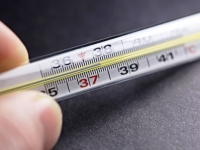allergic reaction
Temperature 37.2 – reason to consult a doctor: what will tell subfebrile
 A serious illness that can develop in the body imperceptibly for the person himself can be “declared” by a slightly increased body temperature. Low-grade fever (37-37.5 ° C) can last for several weeks or months, but does not bother the person. Meanwhile, subfebrile condition can be a symptom of a sluggish inflammatory process or a serious disease.
A serious illness that can develop in the body imperceptibly for the person himself can be “declared” by a slightly increased body temperature. Low-grade fever (37-37.5 ° C) can last for several weeks or months, but does not bother the person. Meanwhile, subfebrile condition can be a symptom of a sluggish inflammatory process or a serious disease.
Body temperature: norm and deviation
So what is the norm and deviation from it, if we are talking about the temperature of the human body? The classic normal temperature of a healthy person is 36.6 ° C. However, these indicators are not always stable and may change under the influence of a number of factors. And this does not mean that something is wrong with you. Temperatures can vary from 35.5 to 37.4 ° C due to the influence of climate, biological rhythms, and time of day. Continue reading
Careful parasites: how not to get infected with animals
 With the onset of summertime, the risk of catching an infection from our smaller brothers increases. In addition to domestic cats and dogs, which during the warm season, the owners more often take to the street, birds, horses, as well as stray cats and dogs, wild animals can “share” worms (viruses), viruses or bacteria.
With the onset of summertime, the risk of catching an infection from our smaller brothers increases. In addition to domestic cats and dogs, which during the warm season, the owners more often take to the street, birds, horses, as well as stray cats and dogs, wild animals can “share” worms (viruses), viruses or bacteria.
In the warm season, when relaxing in a park or a forest, not only babies, but also adults want to feed a squirrel, a pigeon from their hands, or to touch a hedgehog rustling in the grass. But an animal is an animal and touching it, we risk not only being bitten, but also become infected with serious diseases.
What kind of parasites can be infected from animals
Diseases that are transmitted to humans from animals and birds are called zoonoses. Continue reading
Summer without hepatitis A: jaundice prevention
 Jaundice (Botkin’s disease) or hepatitis A is a seasonal disease. It is in the summer and early autumn that infectious disease specialists report outbreaks of jaundice. Hepatitis has several types, but today we will talk about hepatitis A, which, unlike other types of the disease, is transmitted through dirty hands, unwashed vegetables or fruits, water, etc. (fecal-oral route of infection). It is in the summer, in the season of mass outdoor recreation, bathing, walking, picnics, fresh vegetables and fruits, the risk of jaundice increases.
Jaundice (Botkin’s disease) or hepatitis A is a seasonal disease. It is in the summer and early autumn that infectious disease specialists report outbreaks of jaundice. Hepatitis has several types, but today we will talk about hepatitis A, which, unlike other types of the disease, is transmitted through dirty hands, unwashed vegetables or fruits, water, etc. (fecal-oral route of infection). It is in the summer, in the season of mass outdoor recreation, bathing, walking, picnics, fresh vegetables and fruits, the risk of jaundice increases.
Symptoms of Hepatitis A: What Dangerous Disease Continue reading



